[UPDATE: Here's the carnival post: "Healthy Birth Blog Carnival: Walk, move around, and change positions throughout labor" so you can read everyone's entries.]
 I'm getting some help today. The title comes from one of Mikko's favorite Signing Time DVDs (what? They go through my head), the birthing photos come from Christy Scherrer, and the topic comes from Science & Sensibility, a Lamaze International blog that's hosting a series of birth carnivals on Lamaze's principles. (You can join, too! Post by tomorrow, Oct. 25.) This time around, the topic is Lamaze’s second Healthy Birth Practice: Walk, move around, and change positions throughout labor.
I'm getting some help today. The title comes from one of Mikko's favorite Signing Time DVDs (what? They go through my head), the birthing photos come from Christy Scherrer, and the topic comes from Science & Sensibility, a Lamaze International blog that's hosting a series of birth carnivals on Lamaze's principles. (You can join, too! Post by tomorrow, Oct. 25.) This time around, the topic is Lamaze’s second Healthy Birth Practice: Walk, move around, and change positions throughout labor.This in turn relates to the first principle of attachment parenting:
Prepare for Pregnancy, Birth, and Parenting (Birth Bonding)
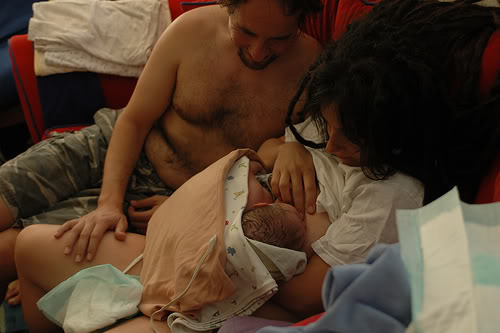 As I mentioned in my attachment parenting primer, the original, narrower focus was to bond with your baby immediately after birth, the better to attach emotionally and initiate breastfeeding.
As I mentioned in my attachment parenting primer, the original, narrower focus was to bond with your baby immediately after birth, the better to attach emotionally and initiate breastfeeding.But doing so means taking a step back and figuring out what path will lead to bonding immediately after birth. Unfortunately, the typical medical model can undermine that bonding process in a number of ways. Mothers and babies are often under the influence of powerful
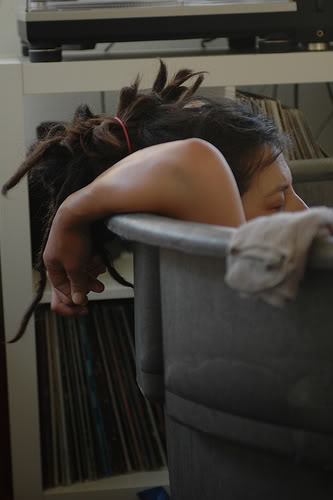 synthetic hormones and numbing medications. Overeager inductions increase the risk of preterm birth, which in turn increases the need for medical attention to the baby or mother immediately following birth. C-sections necessarily separate mother and baby, visually and physically, as both are cared for separately until they can be reunited. Hospital routines and policies can mean that even a baby born after a normal, natural birth is carried off to be wiped down, warmed up, and suctioned out, and have blood tests and needle pricks, before a mother gets to hold her newborn.
synthetic hormones and numbing medications. Overeager inductions increase the risk of preterm birth, which in turn increases the need for medical attention to the baby or mother immediately following birth. C-sections necessarily separate mother and baby, visually and physically, as both are cared for separately until they can be reunited. Hospital routines and policies can mean that even a baby born after a normal, natural birth is carried off to be wiped down, warmed up, and suctioned out, and have blood tests and needle pricks, before a mother gets to hold her newborn.Preventing true medical emergency isn't in our power, but doing what we can as birthing women to keep unnecessary interventions in the birthing process to a minimum will give our babies the best chance of an uncomplicated, serene entry into the world.
There are a lot of methods that work toward that end, but today we'll focus on movement.
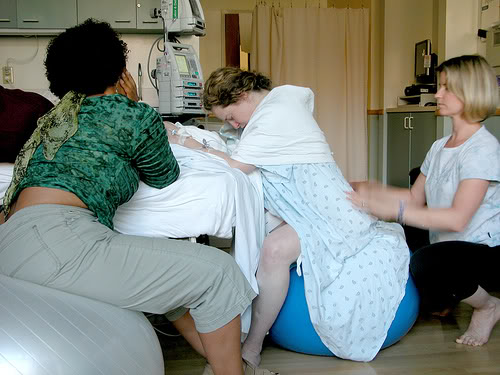 Lying flat on your back during birthing doesn't make much sense if you consider the physics of it. The baby's coming out below, so you might as well sit up, stand up, dance, and walk, and let gravity help you out.
Lying flat on your back during birthing doesn't make much sense if you consider the physics of it. The baby's coming out below, so you might as well sit up, stand up, dance, and walk, and let gravity help you out.Keeping a more upright position allows the baby to continue placing even pressure on your cervix, which stimulates the natural ripening and contracting processes.
I'll give you a little story of how I used movement in birthing, because there was a lot of variety. Feel free to comment with other ideas for women who are anticipating their birthing time to take away.
For the reasons I mentioned above, I intended to have a home birth with licensed midwives in
 attendance. I ended up transferring to a hospital after 39 hours of labor, but I was able to have a natural birth in the hospital with a certified nurse-midwife in attendance and my original midwives acting as doulas. Sam was with me the entire labor, acting as birth partner
attendance. I ended up transferring to a hospital after 39 hours of labor, but I was able to have a natural birth in the hospital with a certified nurse-midwife in attendance and my original midwives acting as doulas. Sam was with me the entire labor, acting as birth partnerNot knowing what was on the inside or how long he would take to emerge, the midwives coached me into a variety of movements and positions to encourage good positioning and a healthy labor, and others I chose for myself instinctually or because of ideas I had read about.
• The first and most important preparation I made was doing the Hypnobabies self-study course
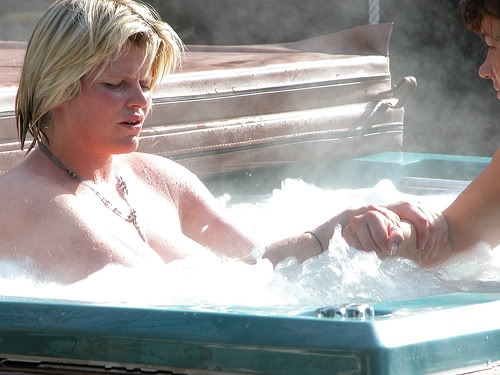 for hypnosis during childbirth (no, they're not giving me any kickbacks...). My Hypnobabies training kept me calm and focused during the 42 hours of my birthing time. I chose Hypnobabies in particular out of the childbirth hypnosis options because it's the method that promotes "eyes-open childbirth hypnosis" — unlike other hypnosis or deep relaxation methods that take place only lying down with eyes closed, the eyes-open hypnosis technique means you can be moving around, talking and aware and still be in a deeply focused and relaxed state. I knew I wanted to use hypnosis, and I knew I wanted to move around during labor, so this was the perfect fit for me!
for hypnosis during childbirth (no, they're not giving me any kickbacks...). My Hypnobabies training kept me calm and focused during the 42 hours of my birthing time. I chose Hypnobabies in particular out of the childbirth hypnosis options because it's the method that promotes "eyes-open childbirth hypnosis" — unlike other hypnosis or deep relaxation methods that take place only lying down with eyes closed, the eyes-open hypnosis technique means you can be moving around, talking and aware and still be in a deeply focused and relaxed state. I knew I wanted to use hypnosis, and I knew I wanted to move around during labor, so this was the perfect fit for me!• When Sam and I were alone for the beginning hours of labor, we sat together in a birthing tub (a kiddie pool
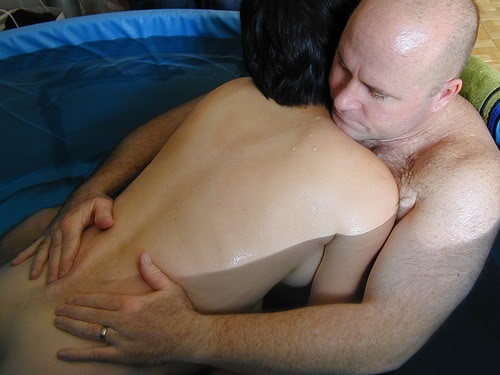 I leaned forward against the inflatable wall of the tub during contractions, and Sam applied counter-pressure on my back since all the intensity was there. (He did this through nearly every contraction for 42 hours. Good man. As a bonus tip for ya, to save his hand strength he switched to using a little wooden massager
I leaned forward against the inflatable wall of the tub during contractions, and Sam applied counter-pressure on my back since all the intensity was there. (He did this through nearly every contraction for 42 hours. Good man. As a bonus tip for ya, to save his hand strength he switched to using a little wooden massager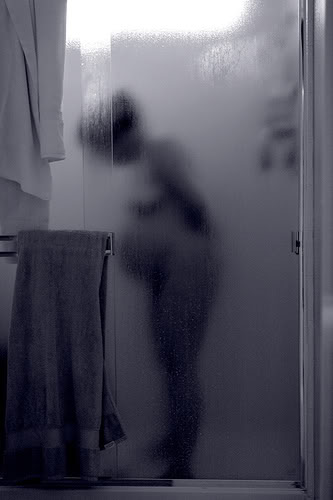 • When the midwives arrived, they didn't want me to sit if possible, so I switched to taking showers instead of sitting in the tub, with the hot water srpay substituting for counterpressure on my back. Thank goodness for the capacious water heater tanks of my apartment building at the time! I put one foot up on the bathtub rim and lunged forward and back during contractions, visualizing the baby turning and facing the right way to slide on out. I also sang songs to him while I stood in the shower — that's not technically much of a movement, but it helped me feel connected and hopeful and motherly. I recommend it!
• When the midwives arrived, they didn't want me to sit if possible, so I switched to taking showers instead of sitting in the tub, with the hot water srpay substituting for counterpressure on my back. Thank goodness for the capacious water heater tanks of my apartment building at the time! I put one foot up on the bathtub rim and lunged forward and back during contractions, visualizing the baby turning and facing the right way to slide on out. I also sang songs to him while I stood in the shower — that's not technically much of a movement, but it helped me feel connected and hopeful and motherly. I recommend it!• The midwives encouraged lots of walking, so Sam and I went on several slow walks along the beach outside our apartment. It was a chilly and cloudy day, so there weren't many onlookers. The one woman who could tell I was in labor said
 something like "Don't worry — they all come out eventually!" as she passed me, which made me smile. The cool temperatures didn't bother me, because I was running a fever (a thankful-anyway thing?), but I must have looked a fright. I was mostly naked at home (all those showers!), so I would throw on a stretchy maternity shirt and a cami, an unbuttoned coat over that, socks to keep my feet warm, and then the sandals that still fit. Apparently labor wasn't a time to be fashion-conscious. During contractions, I stopped and swayed against Sam, holding onto his shoulders in a slow-dance-like pose, or bracing myself against a nearby object so he could apply counterpressure. We also rested on benches and logs along our path. (Shhh...don't tell the midwives.) At the stairs leading down to the beach, I put one foot on a higher step than the other and lunged back and forth during contractions as I'd done in the shower, switching feet for the next contraction. The idea was to get the baby to spin to the optimal position, in case that was what was slowing labor. (He definitely was a little bit tipped, and there was some suggestion that he was face up instead of back. I think most of the positioning issues just had to do with my body getting me slowly ready to fit his tremendous self on through; eventually it all came together.)
something like "Don't worry — they all come out eventually!" as she passed me, which made me smile. The cool temperatures didn't bother me, because I was running a fever (a thankful-anyway thing?), but I must have looked a fright. I was mostly naked at home (all those showers!), so I would throw on a stretchy maternity shirt and a cami, an unbuttoned coat over that, socks to keep my feet warm, and then the sandals that still fit. Apparently labor wasn't a time to be fashion-conscious. During contractions, I stopped and swayed against Sam, holding onto his shoulders in a slow-dance-like pose, or bracing myself against a nearby object so he could apply counterpressure. We also rested on benches and logs along our path. (Shhh...don't tell the midwives.) At the stairs leading down to the beach, I put one foot on a higher step than the other and lunged back and forth during contractions as I'd done in the shower, switching feet for the next contraction. The idea was to get the baby to spin to the optimal position, in case that was what was slowing labor. (He definitely was a little bit tipped, and there was some suggestion that he was face up instead of back. I think most of the positioning issues just had to do with my body getting me slowly ready to fit his tremendous self on through; eventually it all came together.)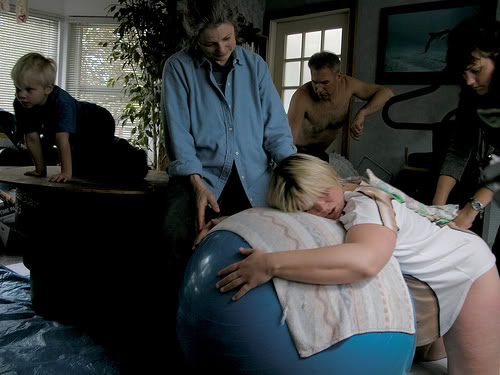
• Back at home, I enjoyed bouncing up and down on a birth ball
• For the times when even sitting was too exhausting, I
 curled up on my bed so I could catch little naps in between contractions. When a new wave would come on, I would get Sam's help to pull myself into a kneeling position, leaning forward on a pillow with my butt in the air. This also was to give the baby plenty of room to turn and to encourage pressure on my cervix.
curled up on my bed so I could catch little naps in between contractions. When a new wave would come on, I would get Sam's help to pull myself into a kneeling position, leaning forward on a pillow with my butt in the air. This also was to give the baby plenty of room to turn and to encourage pressure on my cervix.• I spent time on the toilet, as well as kneeling in front of it. (I had fully intended to eat and drink through labor, but my stomach made other plans!)
• For several reasons that I won't second-guess here and
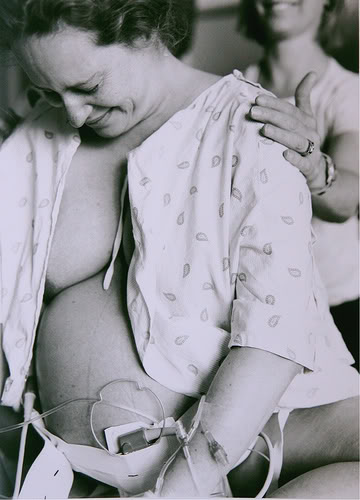 now (though perhaps in a later post), we decided to transfer to the hospital. I won't talk about the horrific car ride because I don't have much advice on how to be comfortable in transition in a car except to say "good luck," and just to hang on and survive it. Once we got to the hospital, I ripped off my clothes again (it had become a habit by that point) and knelt on the bed. Once all the bleeping (in various forms of the word) monitors were attached and questions answered, I finally could get down to pushing. For pushing, I used a squatting bar during some contractions, always resting back into a sitting position in between so I didn't wear myself out. The squatting position was really intense, so I switched to more of a sitting position, with the bed's back in a fairly upright position and my legs pressed up toward my chest. (I'm sure you've seen it on A Baby Story...) That felt more manageable and allowed me to push more intentionally and in a controlled manner.
now (though perhaps in a later post), we decided to transfer to the hospital. I won't talk about the horrific car ride because I don't have much advice on how to be comfortable in transition in a car except to say "good luck," and just to hang on and survive it. Once we got to the hospital, I ripped off my clothes again (it had become a habit by that point) and knelt on the bed. Once all the bleeping (in various forms of the word) monitors were attached and questions answered, I finally could get down to pushing. For pushing, I used a squatting bar during some contractions, always resting back into a sitting position in between so I didn't wear myself out. The squatting position was really intense, so I switched to more of a sitting position, with the bed's back in a fairly upright position and my legs pressed up toward my chest. (I'm sure you've seen it on A Baby Story...) That felt more manageable and allowed me to push more intentionally and in a controlled manner.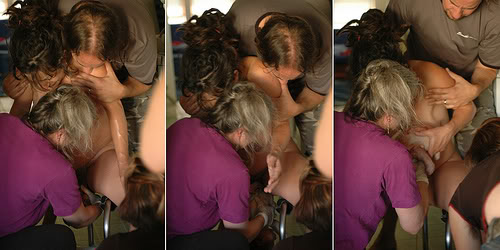
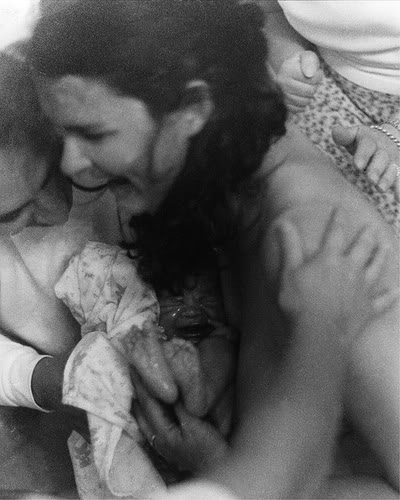
The result of all of these movements during labor?
A healthy, 11 pound, 13 ounce baby boy, born vaginally and without pain medication, who was able to lie skin-to-skin on my chest immediately after the birth and begin his first breastfeeding attempts within several minutes.

Just as a final note: I appreciate that the hospital we went to has a healthy respect for natural birth and allows certified nurse-midwives to practice there. I also appreciated aspects that maybe would not have been common in just any hospital: the availability of a squatting bar, the welcome and respect my licensed midwives received, and that there weren't any goody bags of formula samples. However, in just my few short hours of labor there, I got the impression that no way would I have been able to move as much there as I had been able to at home. The hospital wanted a stretchy monitoring belt around my midsection the whole time, and the nurse in charge of it kept fiddling with it and wanting me to hold still so it could take
 its readings. In contrast, the midwives at my home used a handheld doppler to check the baby's heartbeat at timed intervals, even allowing me to remain in the shower (with the water turned off) while they used it, and then letting me get back to my laboring. Everything about the midwives' monitoring was as unobtrusive as possible while still being conservatively safe in checking on the health of the baby and me, and their suggestions for movement (walking, lunges, showers) were based on their years of experience studying the birthing process and attending births. All this is to say: Either birth at home or a birthing center, or be prepared to do some serious finagling in the hospital to be allowed the movement you need in labor. In that case, consider hiring a doula, particularly if you and your birth partner (like Sam and I both are) are rather shy and not prone to speak up to protest against authority telling you what you can and cannot do. And in any case, if medically prudent, stay at home for as long as you can during the labor, to allow yourself free movement for as long as possible. Yes, it means being strapped in for a crappy car ride, but it's worth
its readings. In contrast, the midwives at my home used a handheld doppler to check the baby's heartbeat at timed intervals, even allowing me to remain in the shower (with the water turned off) while they used it, and then letting me get back to my laboring. Everything about the midwives' monitoring was as unobtrusive as possible while still being conservatively safe in checking on the health of the baby and me, and their suggestions for movement (walking, lunges, showers) were based on their years of experience studying the birthing process and attending births. All this is to say: Either birth at home or a birthing center, or be prepared to do some serious finagling in the hospital to be allowed the movement you need in labor. In that case, consider hiring a doula, particularly if you and your birth partner (like Sam and I both are) are rather shy and not prone to speak up to protest against authority telling you what you can and cannot do. And in any case, if medically prudent, stay at home for as long as you can during the labor, to allow yourself free movement for as long as possible. Yes, it means being strapped in for a crappy car ride, but it's worth 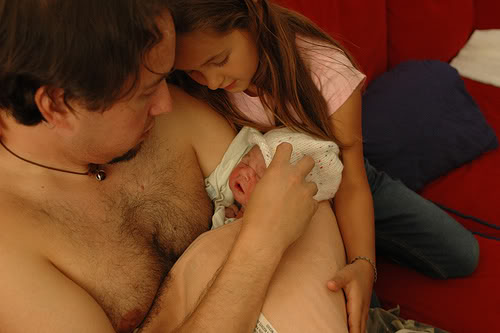 it to avoid being strapped down for the bulk of your labor.
it to avoid being strapped down for the bulk of your labor.So, those are my movement stories from birthing Mikko, the movements that helped propel me toward a natural and uncomplicated birth. What sorts of movements did or didn't work for you? Do you wish you'd moved more?
"Healthy Birth Blog Carnival: Walk, move around, and change positions throughout labor" — visit the carnival link to visit the other excellent entries!
Special thanks to Christy Scherrer for offering up so many
beautiful birth photos under a cc license on flickr.
When I went searching for pictures of movement in labor
to accompany this article, I couldn't resist
making it a gallery of her emotion-rich images.
beautiful birth photos under a cc license on flickr.
When I went searching for pictures of movement in labor
to accompany this article, I couldn't resist
making it a gallery of her emotion-rich images.









 I'm Lauren Wayne, writer and natural parent. I embrace attached parenting with an emphasis toward green living.
I'm Lauren Wayne, writer and natural parent. I embrace attached parenting with an emphasis toward green living. 


2 comments:
Wow - that was an amazing post! thank you so much for sharing your story! I've had two babies and could relate to much of what you experienced, although I had both mine in a hospital. One was a completely natural, med free birth, the other I ended up getting an epidural. Both births, however, were amazing in their own way. Congrats on having such a beautiful birth experience (except for the car ride).
:)MIssy
Yup, movement good, lying down flat on your back so that a nurse can get a good reading on a test strip BAD. I do think the pain of labour guides you into the best possible birthing position -- the one that hurts least -- if you let it. The trick is to trust your body and it will be different for every woman and each birth.
Post a Comment